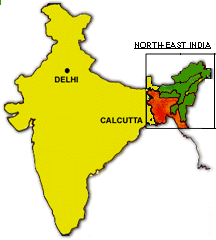
North East of India is untamed and unexplored. North East of India is full of lush green valleys, lofty mountains and tumultuous rivers. They’re home to an extraordinary range of flora and fauna. They’re the states of North East India, whose natural beauty awaits the traveller looking for something different.
Begin your travels in the Himalayan Shangrila of Sikkim,where orchids bloom on the hillside. Journey on to the plains of Assam - tea country and producer of more than half of India’s petroleum. Experience sunrise in Arunachal Pradesh, the first part of India to greet the morning sun. Explore the princely traditions of Tripura, the second smallest Indian state. Discover the tribal crafts and culture of Nagaland. Take home exquisite bamboo and cane souvenirs from Mizoram. Enjoy the marionette-like Manipuri dance of the Land of the Jewels, Manipur. Relax in the sylvan surroundings of the Abode of the clouds, Meghalaya,Welcome to an India you never knew existed.
Begin your travels in the Himalayan Shangrila of Sikkim,where orchids bloom on the hillside. Journey on to the plains of Assam - tea country and producer of more than half of India’s petroleum. Experience sunrise in Arunachal Pradesh, the first part of India to greet the morning sun. Explore the princely traditions of Tripura, the second smallest Indian state. Discover the tribal crafts and culture of Nagaland. Take home exquisite bamboo and cane souvenirs from Mizoram. Enjoy the marionette-like Manipuri dance of the Land of the Jewels, Manipur. Relax in the sylvan surroundings of the Abode of the clouds, Meghalaya,Welcome to an India you never knew existed.


